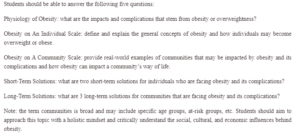Obesity and Overweight Epidemic
Obesity has been observed to have the most serious impact on health. Excess body fat is seen in obese patients due to serious health problems such as cardiovascular diseases, heart disease, stroke, cancer, diabetes type 2, and musculoskeletal disorders such as osteoarthritis. If no intervention is taken, these conditions can lead to serious disabilities or even death. Obesity, therefore, can be defined as an exaggeration of normal adipose tissue. Obesity is the key player in the pathophysiology of diabetes type, dyslipidemia, insulin resistance, atherosclerosis, and hypertension as a result of the secretion of disproportionate adipokines. It is a major contributor to the dysfunction of the metabolism that involves glucose and lipids, and it also influences the organ dysfunctions involving the liver, heart, pulmonary, and endocrine systems (Gadde et al., 2018).
The control of energy expenditure and energy intake are the main mechanisms for achieving energy balance. Based on the above, all calories are equal, and calorie really is a calorie. However, all the calories are unequal when looked beyond pure energic considerations. This, therefore, informs the basis of the pathophysiology of obesity. The imbalance between the intake of calories and energy expenditure causes obesity, and they are always under environmental and genetic influences. This, therefore, leads to abnormalities in the immunologic levels in obese people that are related to the evaluation of tumor factor-alpha and leptin-proopiomelanocortin system (Gadde et al., 2018).
Body mass index (BMI), which is calculated as weight (Kg) divided by meters squared, is the measure used as an individual scale to calculate the fat composition in an individual. A BMI above 30 is considered obese, and it can be subdivided into three categories. These are class I BMI of 30 to > 35, class 2 BMI of 35 to < 40, and class 3 BMI above 40. An individual with a BMI above 40 is always considered to be severely obese.
Obesity-related complications are cardiovascular diseases such as stroke, diabetes type 2, cancer, sleep apnea, osteoarthritis, and severe covid 19 pneumonia. The health problems associated with diabetes can have significant economic consequences on the healthcare system of the United States. These consequences are indirect and direct costs for preventing, diagnosing, and treating obesity. The indirect cost associated with diabetes-related to sickness and death is decreased productivity in a community. In the United States, it is estimated that $79 is spent on the prevention of diabetes per person, and this cumulates to 147 billion in annual expenditures in the fight against obesity (Wang et al., 2018).
Despite the advancement in medicine, there is a single solution for the management of the obesity epidemic. A multifaceted approach that incorporates integration of the local organizations, community and business leaders, childcare, school, individuals, and healthcare providers all working together in the creation of an environment that supports healthy living. The short-term solution in the management of diabetes is public education on the importance of occasional assessment of body weight and eating a healthy diet. The community should always be educated on how to calculate their BMI after assessing their weight and be encouraged to track their calorie intake, plan a diet, and look for food information in order to eat healthily. The long-term solution is encouraging physical activities by teaching the community about different person-centered exercises and the guidelines for exercise needed per day, educating and emphasizing to the parents the importance of establishing healthy behavior in their children and maintaining a healthy weight through taking a healthy diet, exercising, and modifying their behaviors through behavioral change modification (WHO, 2020).
References
Wang, Y., Beydoun, M. A., Min, J., Xue, H., Kaminsky, L. A., & Cheskin, L. J. (2020). Has the prevalence of overweight, obesity and central obesity leveled off in the United States? Trends, patterns, disparities, and future projections for the obesity epidemic. International journal of epidemiology, 49(3), 810-823. https://academic.oup.com/ije/article-abstract/49/3/810/5722224
World Health Organization. (2020). Overweight and obesity. https://www.oecd-ilibrary.org/social-issues-migration-health/health-at-a-glance-asia-pacific-2020_a47d0cd2-en
Gadde, K. M., Martin, C. K., Berthoud, H. R., & Heymsfield, S. B. (2018). Obesity: pathophysiology and management. Journal of the American College of Cardiology, 71(1), 69-84. https://www.jacc.org/doi/abs/10.1016/j.jacc.2017.11.011
The learning objectives for this chapter build upon concepts regarding conditions that may arise from imbalances of nutrients, food intake, and energy. One such condition is obesity and overweight. This assignment requires students to provide two potential short-term solutions for individuals and three potential long-term solutions for communities that face health crises stemming from obesity and its complications.
ORDER A PLAGIARISM-FREE PAPER HERE
We’ll write everything from scratch
Question
Students should be able to answer the following five questions:

Obesity and Overweight Epidemic
Physiology of Obesity: what are the impacts and complications that stem from obesity or overweightness?
Obesity on An Individual Scale: define and explain the general concepts of obesity and how individuals may become overweight or obese.
Obesity on A Community Scale: provide real-world examples of communities that may be impacted by obesity and its complications and how obesity can impact a community’s way of life.
Short-Term Solutions: what are two short-term solutions for individuals who are facing obesity and its complications?
Long-Term Solutions: what are three long-term solutions for communities that are facing obesity and its complications?
Note: the term communities is broad and may include specific age groups, at-risk groups, etc. Students should aim to approach this topic with a holistic mindset and critically understand the social, cultural, and economic influences behind obesity.

